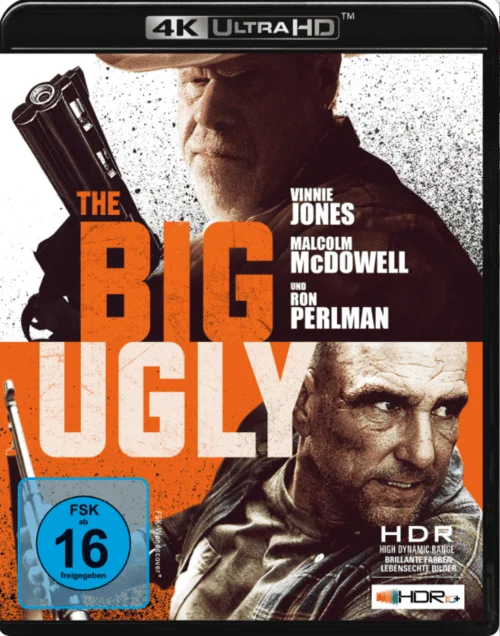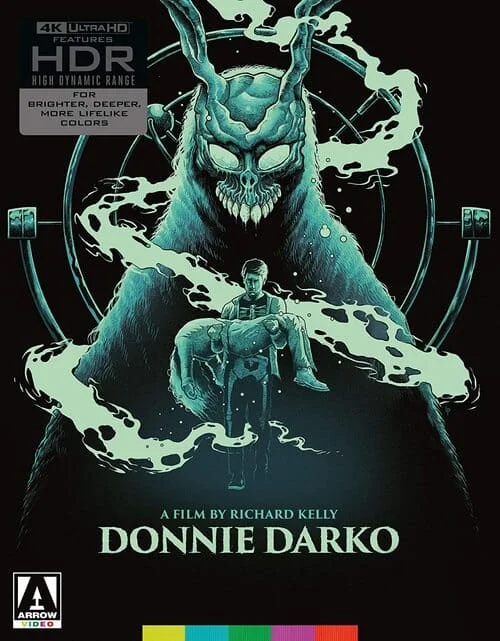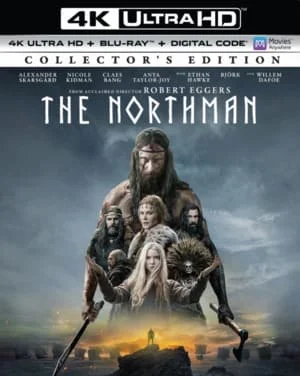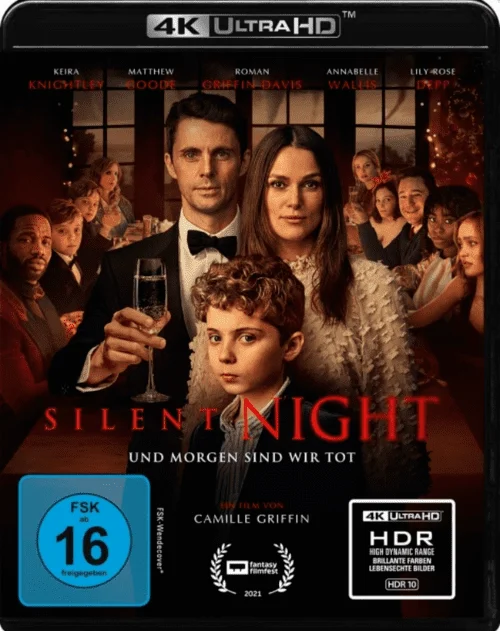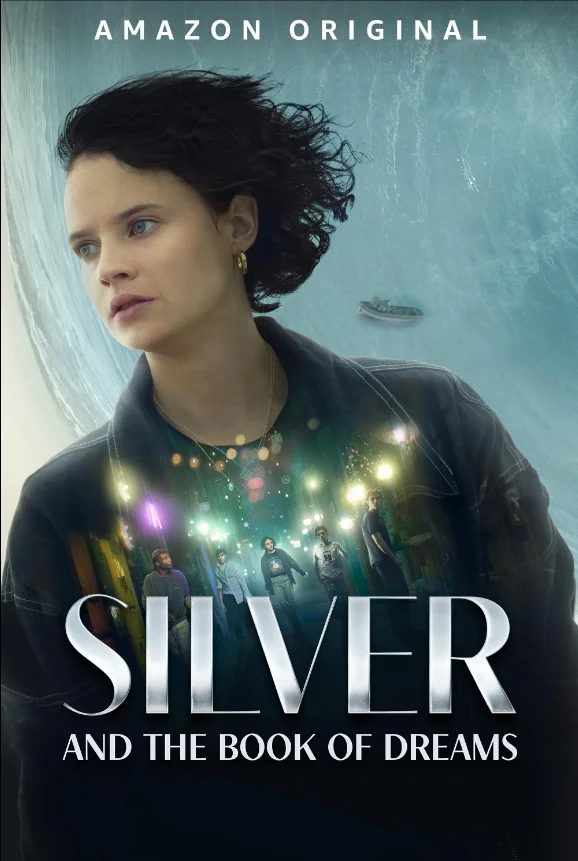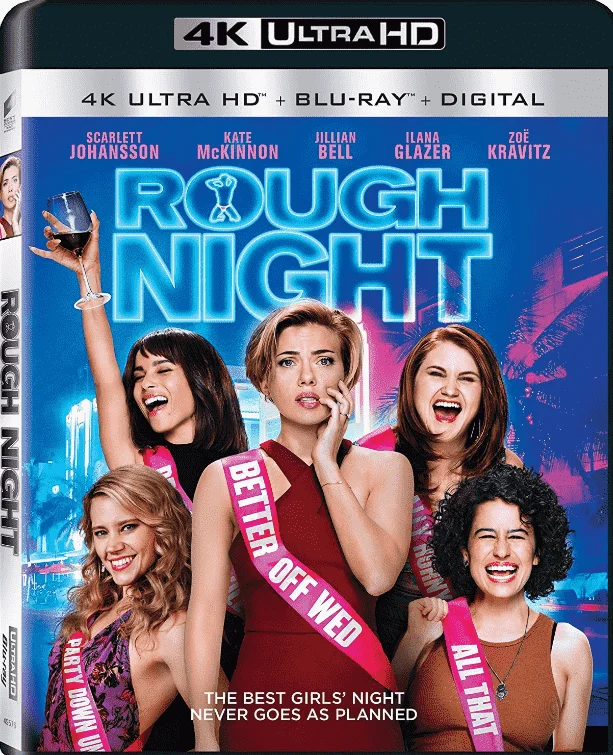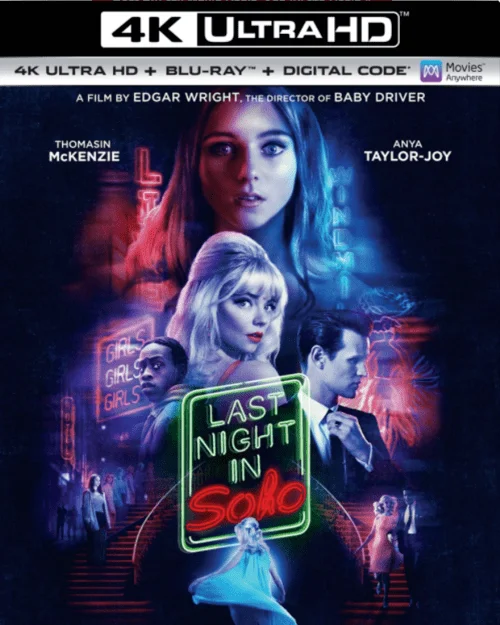
Last Night in Soho 4K 2021 Ultra HD 2160p
Cast: Thomasin McKenzie, Anya Taylor-Joy, Matt Smith, Diana Rigg, Aimee Cassettari, Rita Tushingham, Colin Mace, Michael Ajao, Synnove Karlsen, Jessie Mei Li, Kassius Nelson, Rebecca Harrod, Alan Mahon, Connor Calland, Pauline McLynn, Josh Zaré, Terence Stamp, Jacqui-Lee Pryce.

The plot revolves around young milliner Eloise (McKenzie) who finds herself in 1960s London. There she meets the object of her adoration, the singer Sandy (Taylor-Joy). However, this city is not what it seems. Time begins to disintegrate with grim consequences for the heroine.
Last Night in Soho 4K Review
Eloise (Thomasin MacKenzie) comes from the English province to London to study as a designer - once her mother followed the same dream, but she could not stand the psychological stress and committed suicide (now her image is periodically seen by the girl in the mirrors). Modest and obsessed with retro, she does not really fit into the fashionable student crowd and therefore moves from the hostel to a rented room in an old house. At night, having fallen asleep in a new place, Eloise suddenly moves to London so close to her in the 60s, where she watches the singer Sandy (Anya Taylor-Joy) trying to break into the capital's show business with the help of a cunning manager Jack (Matt Smith). What the girl initially perceives as harmless dreams turns out to be something more: she sees in life places from her fantasies that she could not know about, and meets the same people who have aged half a century. Dreams, meanwhile, are getting darker, and every night the line with reality is gradually blurred.
Director Edgar Wright himself looks like a man who would like to live in the past - when the grass was greener, films were shot better, no one had heard of streaming, and the theaters played Bondiana with Sean Connery. From his first works, it was not very clear: there are too many references and styles mixed in "Zombie named Sean" or "Hoppy type". But it became obvious with the release of "Baby Driver" - a seventies action game inspired by Walter Hill's "Driver" and other classic robbery thrillers. Last Night in Soho continues to look back for sources of cinematic power: 1960s British horror films, Roman Polanski and Nicholas Roeg have taken Hill's place, but the method has remained the same. If Wright used to laugh at clichés and play with them postmodernistically, now he makes pure genre films, no less cinephilic, by the way.
Yes, and it would be strange after the final of the trilogy "Cornetto" to continue to go in the same direction - even if Wright is in it and how good the horror is. He found a new way to express his love for cinema: not through imitation and ironic smirk, but through an adaptation of the style, an attempt to revive the "spirit" of those great films of the past. This is generally one of the key features of "Last Night in Soho" (and "Baby Driver" too) - with all the obvious borrowings and nods towards older comrades, Wright's films cannot be called an exact pastiche. He makes his films not on the basis of the classics that impressed him in childhood, but on the basis of memories of those classics. Simply put, Last Night in Soho is not Disgusted or Don't Look Now. This is how Repulsion was probably perceived by the impressionable little Edgar Wright decades ago.
Neither Rogue nor Polanski would have made such a movie, they simply could not technically. And the point is not only, in fact, the difference in the available instruments: "Last Night in Soho" shows some kind of transcendental possession of director's choreography. It's one of the rare films where it's not embarrassing to ask questions like, "How the hell is this even filmed?" The camera spins in a complex dance, gray London instantly turns into a lively and bright retro postcard, reality collides with a magical looking glass, reflections become reflected. Last Night in Soho is an absolute plastic masterpiece, establishing Wright as one of the premier craftsmen in modern cinema.
It turns out that his style remains recognizable even without branded catchy transitions and visual humor - in long single-take scenes with complex in-frame editing, in the ability to work with light and color: Wright floods Soho with bright neon lights, but never looks like an imitator of the conventional Refn or another indie director of A24 studio. In general, it doesn't seem to fit very well into the space of modern horror, divided by journalists into the "smart" post-horror of the conditional Astaire or Eggers and conservative "horror films" a la James Wan. He's not interested in all those lofty breaths and lengths, "Last Night in Soho" isn't afraid to be loud, expressive, and maybe a bit vulgar. Another thing is that even such a trick, hated by "smart" horror, like a screamer, works flawlessly for him - it turns out that it's not about the tools, but about those who use them.
At the same time, you can't call Soho stupid either. The film at least gracefully plays with the theme of phantom nostalgia - a popular idea among young (and not only) that life was much more pleasant back then, but they were simply unlucky enough to miss the era. Wright himself here reconstructs the beautiful London of the past, which he had never seen: the director was born ten years after the rebellious sixties. His retrograde heroine Eloise at first admires the fairy-tale world from her dreams (dreams?), but over time she realizes that a hell is hiding behind the postcard facade, like behind the scenes of trendy bars someone is right now being put through the vein or selling the body for money. Reveling in the aesthetics of the 60s, Wright at the same time reflects on his own passion for nostalgia, discovering that there is nothing good in stupid looking back. He takes the style of an era apart until it's just colors, echoes of old music, and scary men in smart tuxedos. The further the film goes, the more fragmented, conditional the past becomes in it - and the more terrible.
Perhaps only the final does not work for Wright - in it the genre plot collides forehead with the author's statement (about what exactly - already a spoiler) and does not find a compromise with it. The director, in whose scripts there is usually not a single superfluous phrase, suddenly gets confused in his thoughts and does not find the right words, comes to an uneven, unjustifiably conciliatory ending. What a shame: if Soho also had a congenial end to the rest of the picture, cinema in 2021 could be officially closed. But to some extent, this roughness is even encouraging: it turns out that Wright is still a living, capable of making mistakes, and sometimes he can fail - not to make a great movie, but just very good.
File size: 28.4 GB
Trailer Last Night in Soho 4K 2021 Ultra HD 2160p
Latest added movies
Comments on the movie
Add a comment
 like
like do not like
do not like
